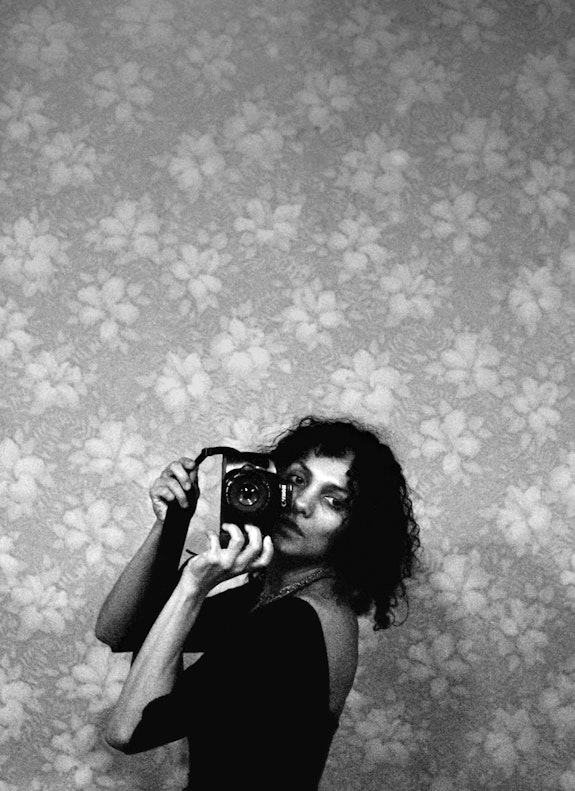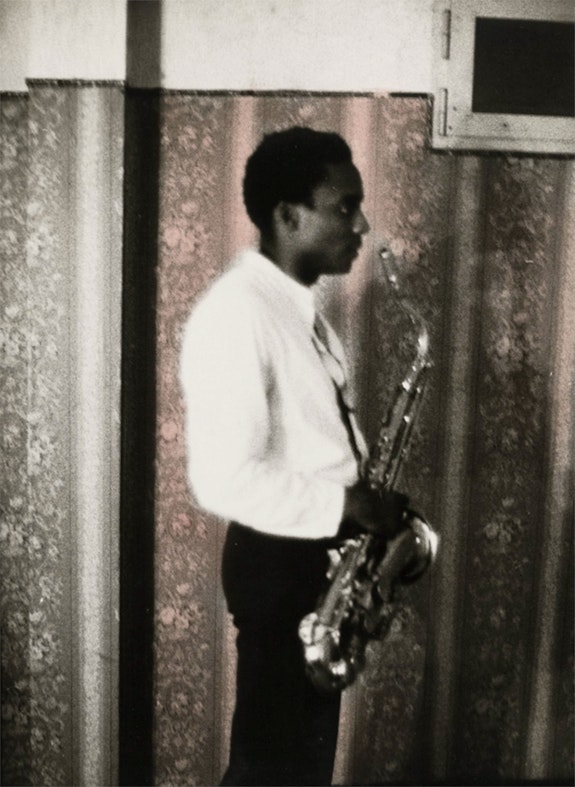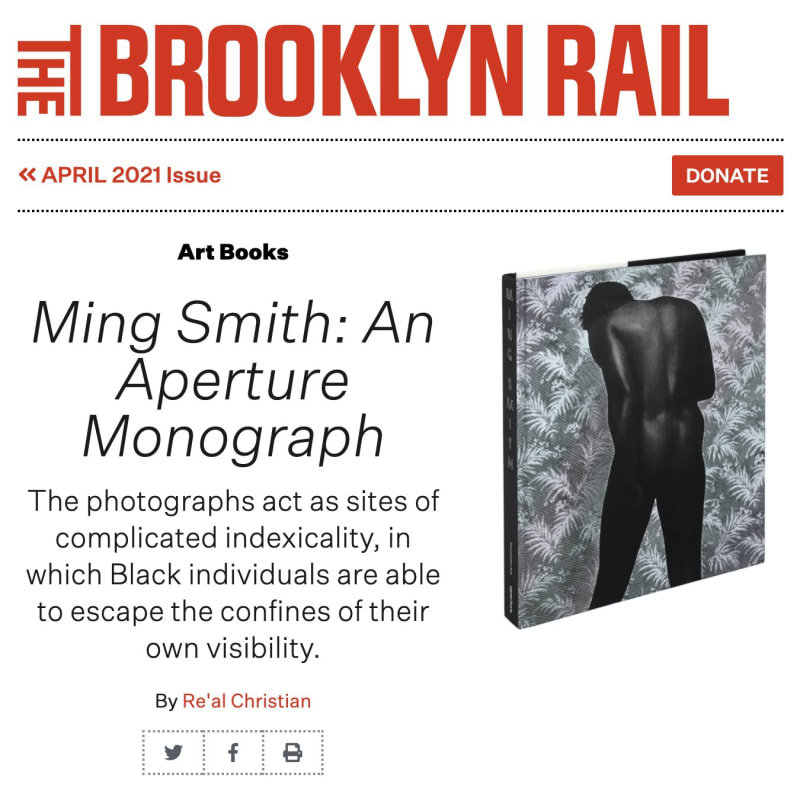The photographs act as sites of complicated indexicality, in which Black individuals are able to escape the confines of their own visibility.
In a black-and-white self-portrait taken in around 1988, photographer Ming Smith stares longingly at her reflection in a mirror. She holds a Canon camera firmly against the side of her face, with her fingers clasped around the device, bracing for the sound of the shutter. Wearing a dark, fitted scoop-back dress, she resembles a dancer, emphasized by the litheness of her limbs as she clutches her camera, but also in her careful self-observation. I was a dancer for many years, and spent much of my time looking into mirrors in this way, tethered to my own reflection as I trained my body through repetitive movements. With this prolonged observation comes a deep consciousness of the self, both psychologically and physically—over time, you become hyper-aware of how your body looks, feels, and moves through space. Smith had aspirations of becoming a dancer growing up in Columbus, Ohio in the 1950s and 1960s. Looking at her portrait, I recognize a familiar, inescapable awareness of the gaze, one that contrasts with much of her other photographic work. With a signature “blurriness,” Smith’s subjects are often difficult to make out or identify, effectively denying the gaze. In doing so, her photographs act as sites of complicated indexicality, in which Black individuals are able to escape the confines of their own visibility.

Smith’s self-portrait is the first image featured in Ming Smith: An Aperture Monograph, co-published by Aperture and Documentary Arts. Encased in an iridescent hardcover offset with a grisaille photograph, Male Nude (1971), the monograph reproduces over 100 images in color and black-and-white. Contributions by Emmanuel Iduma, Arthur Jafa, M. Neelika Jayawardane, Yxta Maya Murray, Hans Ulrich Obrist, Namwali Serpell, Janet Hill Talbert, and Greg Tate delve into the artist’s myriad influences from Impressionist painting to Afrofuturism, spanning four decades of Smith’s life and career.
In 1973, Smith moved to New York after graduating from Howard University, and soon after became the first female member of the Kamoinge Workshop, a collective of Black photographers. It was here that she began to develop her signature technique, utilizing slow shutter speeds, double exposure, and hand-tinting to blur the subjects of her photographs. In 1979, she became the first Black woman photographer to have her work acquired by the Museum of Modern Art, with David Murray in the Wings, Padova, Italy (1978), a hand-tinted photograph of her then-husband; and Christmas Constellation, Brussels, Belgium (1978), a hazy black-and-white image of a well-dressed woman backlit by Christmas tree lights. Other photographs, such as Grace Jones at Studio 54 (1978) and Red Hot Jazz (1979), embody the frenetic energy of Smith’s characteristic blur. These images represent in-between actions, moments that evade precise documentation. Like dance, her photography centers on “always looking at lines and the quality of the movement,” as she remarks in conversation with Janet Hill Talbert. “It’s about seeking energy, breath, and light. The image is always moving, even if you’re standing still.”
Smith’s self-portraits are juxtaposed with photographs of her modeling work, which she began in New York to support her artistic career. In the modeling images, we see a glamourous version of Smith presented in stark contrast to her own portraits that, by comparison, communicate a critical attention to the constructs and signifiers of mainstream beauty. The hand-colored photograph Me as Marilyn (1991), for instance, depicts Smith styled as Marilyn Monroe, with a low-cut dress, blonde hair, and red lipstick. The portrait recalls Andy Warhol’s silkscreen Gold Marilyn Monroe (1962), which features a publicity still of Monroe's face centered on a large gold-painted canvas. The garishness of Warhol’s portrait, like Smith’s reproduction, transforms the subject it represents into a symbol. But in Smith’s portrait, as Yxta Maya Murray argues, she creates a new visual iconography centered on Black femininity.

While photographs like Me as Marilyn embrace the possible pleasure of being looked at, others deny this pleasure. Her style has been characterized as “jazz photography,” owing to its improvised, vibrational quality, but there is an intentionality to her work that weaves her subjects in and out of legibility. As Namwali Serpell writes, one of Smith’s greatest influences was experimental jazz composer and Afrofuturist pioneer, Le Sony’r Ra, better known as Sun Ra. Smith’s photographs, Sun Ra space I and Sun Ra space II (1978) represent two moments of one continuous action, as Sun Ra twirls in front of the camera wearing a glittery cape as an orchestra plays on in the background. Captured in this fleeting moment, the figures are almost spectral, as both the camera and subjects remain in motion, constantly vibrating as the foreground and background merge into one ambiguous space. Refusing visibility is one of the principles of Afrofuturism, communicated through the blur—with this denial, Black identity can exist in an imperceptible space, escape definability, and by extension constraint.
A number of Black writers have inspired Smith’s work. Two Pool Players, Pittsburgh, Pennsylvania (1991) and Mother and Child Deciding (1991) were taken in the Hill District of Pittsburgh for the series “August Moon for August Wilson” (1991), which pays homage to both the playwright and the community of his hometown. Smith’s subjects, like Wilson’s characters, become part of an “ensemble of actors,” observes M. Neelika Jayawardane, “emphasizing the role of community for Black people’s survival, and for creating joy in each other’s company.” Borrowing its name from Ralph Ellison’s famous novel, Smith’s “Invisible Man” series (1988–91) once again navigates spaces on the threshold of visibility. In 1972, Smith was sent to Dakar on a modeling assignment. Her photograph Prelude to Middle Passage (1972) depicts a silhouetted figure on Gorée, a Senegalese island associated with the Atlantic slave trade. The figure is completely hidden, enveloped in shadows as they look out into the abyss. As Emmanuel Iduma writes, our inability to identify this person, who bears witness to a site of traumatic history, evokes a concept by Martinique writer Édouard Glissant: “the right to opacity,” a demand that allows marginalized others to escape the ever-surveillant gaze of their oppressors. In Invisible Man (1998), a male figure blurs and fades into the shadows as he walks away from Smith’s camera, literally on the precipice of darkness. As he treads these dualistic spaces, he conjures the words of another Martinique writer, Frantz Fanon’s proclamation, “I am not merely here-and-now.”
In complicating the readability of her subjects, Smith explores the liminal spaces in which Black identity can exist without reproach. Arthur Jafa, in conversation with Greg Tate, describes it as “a commitment to being in those spaces that Black people occupy. The spaces that are underlit.” Her figures do not necessarily need to be blurred to refuse us readability, or to have their own interiority. The “Black fugitivity” of these images, as Jafa and Tate discuss, is anchored in a desire for self-actualization rather than escape.
The blur is “not a post-moment,” as Smith notes in an interview with Hans Ulrich Obrist, which closes the monograph. “It’s freedom, it’s what happens between here and there and time.” To “blur” oneself in the manner Smith has devised has a utopian potentiality—to move freely through spaces and to remain unseen, or untethered, from the otherizing gaze. With images of jazz musicians, dancers, family members, Harlem hangouts and parades, Smith captures both celebrated and quotidian moments of Black life. Her photographs become a kind of ghostly palimpsest for representation, constantly writing and rewriting ever-changing definitions of Black identity.
Contributor

